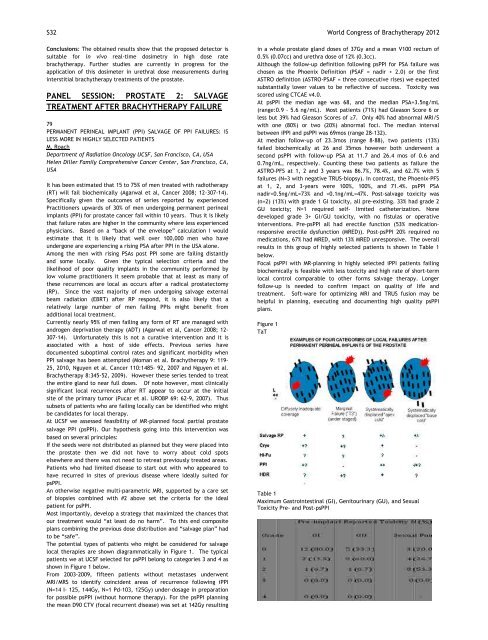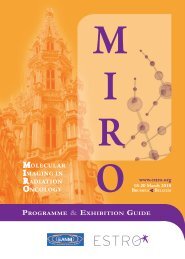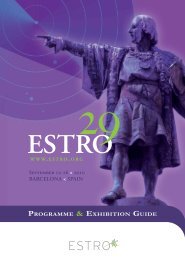World Congress of Brachytherapy 10-12 May, 2012 - Estro-events.org
World Congress of Brachytherapy 10-12 May, 2012 - Estro-events.org
World Congress of Brachytherapy 10-12 May, 2012 - Estro-events.org
You also want an ePaper? Increase the reach of your titles
YUMPU automatically turns print PDFs into web optimized ePapers that Google loves.
S32 <strong>World</strong> <strong>Congress</strong> <strong>of</strong> <strong>Brachytherapy</strong> 20<strong>12</strong><br />
: The obtained results show that the proposed detector is<br />
suitable for in vivo realtime dosimetry in high dose rate<br />
brachytherapy. Further studies are currently in progress for the<br />
application <strong>of</strong> this dosimeter in urethral dose measurements during<br />
interstitial brachytherapy treatments <strong>of</strong> the prostate.<br />
<br />
<br />
79<br />
PERMANENT PERINEAL IMPLANT (PPI) SALVAGE OF PPI FAILURES: IS<br />
LESS MORE IN HIGHLY SELECTED PATIENTS<br />
M. Roach<br />
Department <strong>of</strong> Radiation Oncology UCSF, San Francisco, CA, USA<br />
Helen Diller Family Comprehensive Cancer Center, San Francisco, CA,<br />
USA<br />
It has been estimated that 15 to 75% <strong>of</strong> men treated with radiotherapy<br />
(RT) will fail biochemically (Agarwal et al, Cancer 2008; <strong>12</strong>30714).<br />
Specifically given the outcomes <strong>of</strong> series reported by experienced<br />
Practitioners upwards <strong>of</strong> 30% <strong>of</strong> men undergoing permanent perineal<br />
implants (PPI) for prostate cancer fail within <strong>10</strong> years. Thus it is likely<br />
that failure rates are higher in the community where less experienced<br />
physicians. Based on a “back <strong>of</strong> the envelope” calculation I would<br />
estimate that it is likely that well over <strong>10</strong>0,000 men who have<br />
undergone are experiencing a rising PSA after PPI in the USA alone.<br />
Among the men with rising PSAs post PPI some are failing distantly<br />
and some locally. Given the typical selection criteria and the<br />
likelihood <strong>of</strong> poor quality implants in the community performed by<br />
low volume practitioners it seem probable that at least as many <strong>of</strong><br />
these recurrences are local as occurs after a radical prostatectomy<br />
(RP). Since the vast majority <strong>of</strong> men undergoing salvage external<br />
beam radiation (EBRT) after RP respond, it is also likely that a<br />
relatively large number <strong>of</strong> men failing PPIs might benefit from<br />
additional local treatment.<br />
Currently nearly 95% <strong>of</strong> men failing any form <strong>of</strong> RT are managed with<br />
androgen deprivation therapy (ADT) (Agarwal et al, Cancer 2008; <strong>12</strong><br />
30714). Unfortunately this is not a curative intervention and it is<br />
associated with a host <strong>of</strong> side effects. Previous series have<br />
documented suboptimal control rates and significant morbidity when<br />
PPI salvage has been attempted (Moman et al. <strong>Brachytherapy</strong> 9: 119<br />
25, 20<strong>10</strong>, Nguyen et al. Cancer 1<strong>10</strong>:1485 92, 2007 and Nguyen et al.<br />
<strong>Brachytherapy</strong> 8:34552, 2009). However these series tended to treat<br />
the entire gland to near full doses. Of note however, most clinically<br />
significant local recurrences after RT appear to occur at the initial<br />
site <strong>of</strong> the primary tumor (Pucar et al. IJROBP 69: 629, 2007). Thus<br />
subsets <strong>of</strong> patients who are failing locally can be identified who might<br />
be candidates for local therapy.<br />
At UCSF we assessed feasibility <strong>of</strong> MRplanned focal partial prostate<br />
salvage PPI (psPPI). Our hypothesis going into this intervention was<br />
based on several principles:<br />
If the seeds were not distributed as planned but they were placed into<br />
the prostate then we did not have to worry about cold spots<br />
elsewhere and there was not need to retreat previously treated areas.<br />
Patients who had limited disease to start out with who appeared to<br />
have recurred in sites <strong>of</strong> previous disease where ideally suited for<br />
psPPI.<br />
An otherwise negative multiparametric MRI, supported by a care set<br />
<strong>of</strong> biopsies combined with #2 above set the criteria for the ideal<br />
patient for psPPI.<br />
Most importantly, develop a strategy that maximized the chances that<br />
our treatment would “at least do no harm”. To this end composite<br />
plans combining the previous dose distribution and “salvage plan” had<br />
to be “safe”.<br />
The potential types <strong>of</strong> patients who might be considered for salvage<br />
local therapies are shown diagrammatically in Figure 1. The typical<br />
patients we at UCSF selected for psPPI belong to categories 3 and 4 as<br />
shown in Figure 1 below.<br />
From 20032009, fifteen patients without metastases underwent<br />
MRI/MRS to identify coincident areas <strong>of</strong> recurrence following iPPI<br />
(N=14 I <strong>12</strong>5, 144Gy, N=1 Pd<strong>10</strong>3, <strong>12</strong>5Gy) underdosage in preparation<br />
for possible psPPI (without hormone therapy). For the psPPI planning<br />
the mean D90 CTV (focal recurrent disease) was set at 142Gy resulting<br />
in a whole prostate gland doses <strong>of</strong> 37Gy and a mean V<strong>10</strong>0 rectum <strong>of</strong><br />
0.5% (0.07cc) and urethra dose <strong>of</strong> <strong>12</strong>% (0.3cc).<br />
Although the followup definition following psPPI for PSA failure was<br />
chosen as the Phoenix Definition (PSAF = nadir + 2.0) or the first<br />
ASTRO definition (ASTROPSAF = three consecutive rises) we expected<br />
substantially lower values to be reflective <strong>of</strong> success. Toxicity was<br />
scored using CTCAE v4.0.<br />
At psPPI the median age was 68, and the median PSA=3.5ng/mL<br />
(range:0.9 5.6 ng/mL). Most patients (71%) had Gleason Score 6 or<br />
less but 39% had Gleason Scores <strong>of</strong> ≥7. Only 40% had abnormal MRI/S<br />
with one (80%) or two (20%) abnormal foci. The median interval<br />
between iPPI and psPPI was 69mos (range 28132).<br />
At median followup <strong>of</strong> 23.3mos (range 888), two patients (13%)<br />
failed biochemically at 26 and 35mos however both underwent a<br />
second psPPI with followup PSA at 11.7 and 26.4 mos <strong>of</strong> 0.6 and<br />
0.7ng/mL, respectively. Counting these two patients as failure the<br />
ASTROPFS at 1, 2 and 3 years was 86.7%, 78.4%, and 62.7% with 5<br />
failures (N=3 with negative TRUSbiopsy). In contrast, the PhoenixPFS<br />
at 1, 2, and 3years were <strong>10</strong>0%, <strong>10</strong>0%, and 71.4%. psPPI PSA<br />
nadir <strong>12</strong> months is associated<br />
with a low risk <strong>of</strong> systemic progression and 92% remain metastasis<br />
free at 5 years.<br />
Surgical technique<br />
Nowadays with most patients undergoing EBRT, perineal low or high<br />
dose brachytherapy the standard retropubic approach is preferred for<br />
salvage RPE. Depending on the type <strong>of</strong> radiation technique there are<br />
different anatomical areas in which the surgical procedure might be<br />
complicated (table 1) and deserves specific experience.<br />
Complications: Rectal injury has been described in 6% to 19% <strong>of</strong><br />
patients in former series whereas it is reported in only 25% <strong>of</strong><br />
patients in modern series.<br />
Anastomotic strictures occur more frequently in 832%<br />
The incidence if urinary stress incontinence is higher than in series <strong>of</strong><br />
primary RPE. Complete continence can be achieved in about 50%,<br />
another 20% to 30% require only 1 pad per day. The radiation<br />
technique used appears to be associated with the frequency <strong>of</strong><br />
incontinence: in the author’s experience a high continence rate <strong>of</strong><br />
90% could be achieved in patients having undergone LDR<br />
brachytherapy.<br />
Cancer control following SRP<br />
The 5year progressionfree rates have improved and the results are<br />
similar to those <strong>of</strong> standard RPE in cases <strong>of</strong> similar pathological<br />
stages. The <strong>10</strong>year cancer specific and overall survival rates are in<br />
the range <strong>of</strong> 70% to 75% and 60% to 66% in contemporary series. In<br />
most contemporary series, <strong>org</strong>anconfined disease, negative surgical<br />
margins and the absence <strong>of</strong> seminal vesicle and/or lymph node<br />
metastases are favourable prognosticators associated with a better<br />
diseasefree survival <strong>of</strong> approximately 7080%.<br />
: With the advantage <strong>of</strong> PSA screening at regular followup<br />
intervalls following RT, most local failures will be detected by an<br />
asymptomatic PSA increase. Patients with PSA levels < <strong>10</strong> ng/ml, no<br />
palpable disease, negative findings on CT and bone scans are most<br />
suitable candidates for SRP. Contemporary series <strong>of</strong> SRP demonstrate<br />
excellent local control, good longterm cancer specific survival rates,<br />
minimal complication rates and a good health related quality <strong>of</strong> life.<br />
SRP represents the therapeutic option if choice in well selected<br />
patients with locally recurrent PCA preventing significant local<br />
complications. Based on our most recent findings on 117 patients SRP<br />
should only be performed at tertiary referral centres with an<br />
extensive experience not only in radical prostatectomy but especially<br />
in salvage surgery.<br />
<br />
OC81<br />
A MULTICENTRE COMPARISON OF INTER AND INTRAFRACTIONAL<br />
ORGAN MOVEMENT IN CERVIX CANCER BT AND ITS DOSIMETRIC IMPACT<br />
N. Nesvacil 1 , K. Tanderup 2 , T. PaulsenHellebust 3 , A. De Leeuw 4 ,<br />
C. Anderson 5 , S. Mohamed 2 , R. Pötter 6 , C. Kirisits 6<br />
1<br />
Medical University <strong>of</strong> Vienna, Department <strong>of</strong> Radiotherapy and<br />
Oncology Comprehensive Cancer Center, Vienna, Austria<br />
2<br />
Aarhus University Hospital, Department <strong>of</strong> Oncology, Aarhus,<br />
Denmark<br />
3<br />
Oslo University Hospital, Department <strong>of</strong> Medical Physics Division <strong>of</strong><br />
Cancer and Surgery, Oslo, Norway<br />
4<br />
University Medical Center Utrecht, Department <strong>of</strong> Radiation<br />
Oncology, Utrecht, The Netherlands<br />
5<br />
Mount Vernon Cancer Centre, Clinical Physics Department,<br />
Northwood Middlesex, United Kingdom<br />
6<br />
Medical University <strong>of</strong> Vienna, Department <strong>of</strong> Radiotherapy and<br />
Oncology Comprehensive Cancer Center & Christian Doppler<br />
Laboratory for Medical Radiation Research for Radiation Oncology,<br />
Vienna, Austria<br />
: Inter and intrafractional <strong>org</strong>an motion plays an<br />
important role in multifractional brachytherapy treatment when one<br />
dose plan is used for multiple fractions, or when <strong>org</strong>an movement<br />
happens in between imaging and dose delivery. The dosimetric impact<br />
<strong>of</strong> such motions has been reported previously in singleinstitutional<br />
studies.<br />
The aim <strong>of</strong> this study is to compare the dosimetric impact <strong>of</strong> <strong>org</strong>an<br />
position variations by a retrospective multicentre analysis with<br />
different application techniques and fractionation schemes.<br />
: Data from 5 centers in the GYNGEC ESTRO<br />
Network using intracavitary (tandem/ovoid or tandem/ring)<br />
applicators +/ interstitial needles were collected.<br />
To assess dosimetric effects <strong>of</strong> the motion <strong>of</strong> critical <strong>org</strong>ans (bladder,<br />
rectum, sigmoid) between treatment fractions, multiple image scans<br />
(MRI or CT) were analysed. OAR were contoured on images at the time<br />
<strong>of</strong> BT planning as well as on a subsequent image series acquired prior<br />
to treatment <strong>of</strong> a subsequent HDR or PDR fraction. Dose plans<br />
generated by using the 1 st image series were superimposed onto the<br />
subsequent image sets and DVH parameters were calculated.<br />
DVH data for a total <strong>of</strong> 96 patients was available (323 image/contour<br />
sets, 254 MRI, 69 CT). DVH data for 16 fractions were available for<br />
each patient. The average time between consecutive image<br />
acquisitions varied between centers, from several hours to several<br />
days (mean 73 h, median 22 h, range 5 h – 22 d).<br />
: For each patient, D2cc for bladder, rectum and sigmoid were<br />
calculated based on images and contour sets acquired at different<br />
times during the BT treatment (at time <strong>of</strong> planning (D2cc_1) + at time









